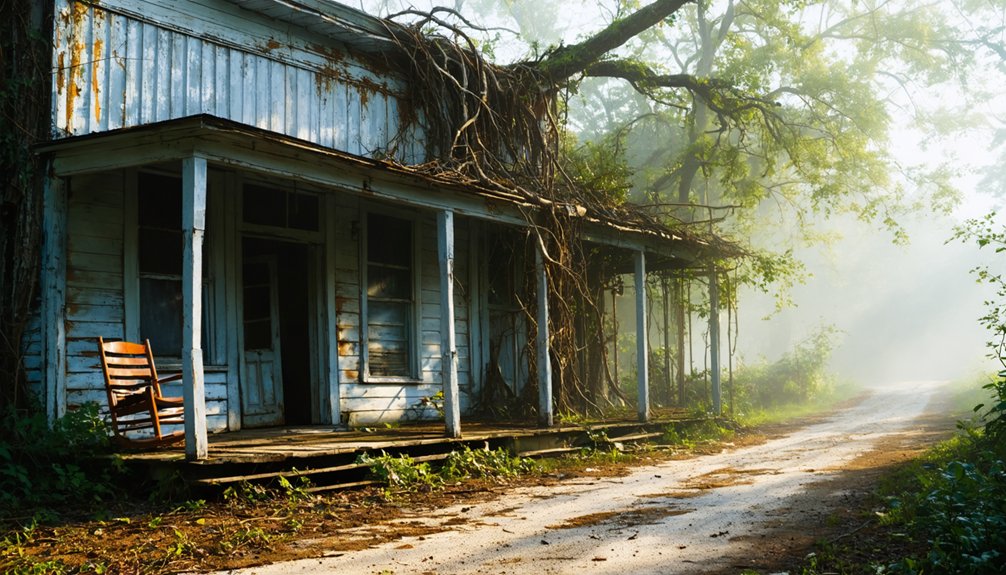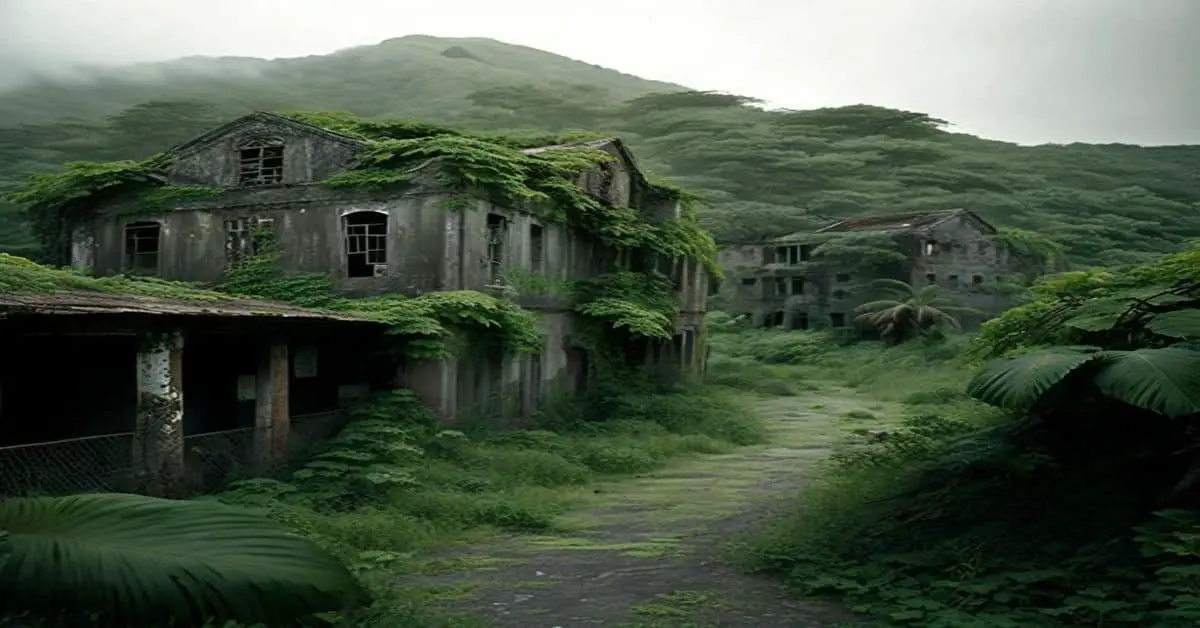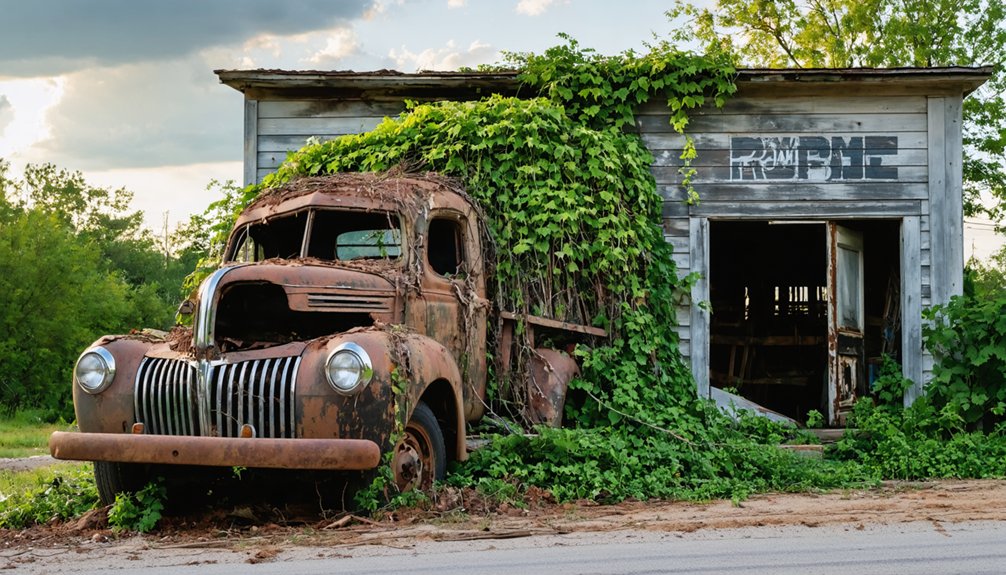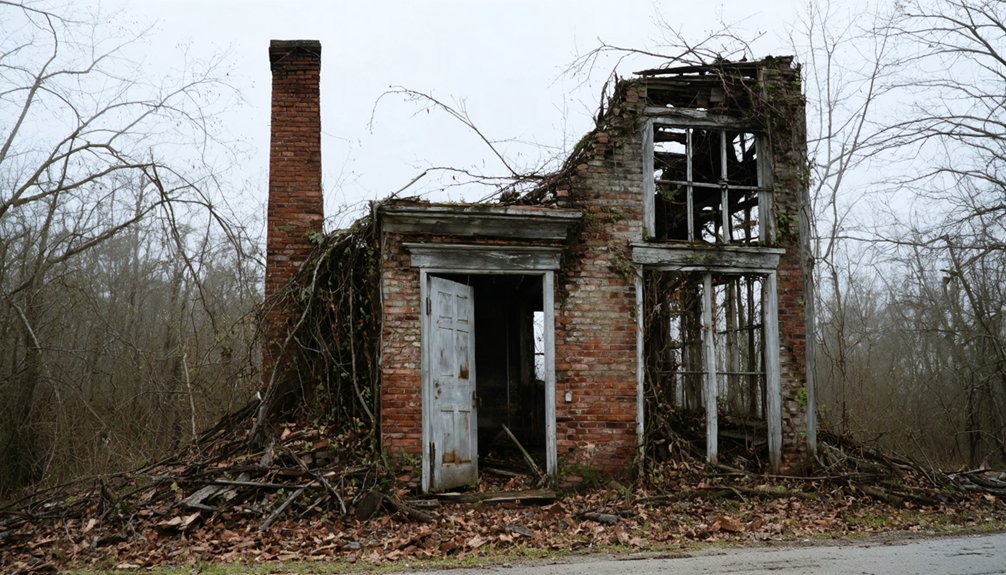You’ll find Cedric about 3-4 miles southeast of Roanoke in northeastern Chambers County, Alabama. This ghost town emerged during the 19th century’s rural expansion, known for its pottery production and agricultural pursuits, particularly the work of notable potter Joseph Rushton. While the settlement’s prominence was short-lived, it became a symbol of Alabama’s agricultural heritage with its 440-acre farmland. Today, the site remains on private property, its stories and artifacts carefully guarded by time and ownership.
Key Takeaways
- Cedric is a ghost town in northeastern Chambers County, Alabama, located approximately 3-4 miles southeast of Roanoke on private property.
- The town emerged during the 19th century but declined due to limited economic diversification and isolation from major transportation routes.
- Cedric’s economy centered on rural farming activities, including cotton, tobacco, and soybean cultivation, along with notable pottery production.
- The ghost town is completely inaccessible to the public without explicit landowner permission and lacks historical markers or viewing areas.
- The site has no historical preservation status and remains vulnerable to development or decay due to its private property status.
Location & Historical Context
Located in northeastern Chambers County, Alabama, Cedric stands as a tribute to the region’s rural settlement patterns, positioned roughly 3-4 miles southeast of present-day Roanoke and a mile southwest of Bacon Level Church.
You’ll find this ghost town nestled within private property boundaries, where the Cedric community once emerged as part of Alabama’s northeastern settlement expansion. The site exemplifies the abandoned settlements that dot Alabama’s landscape.
Unlike more established towns of its era, Cedric never developed significant infrastructure or became an administrative hub. Instead, it remained a modest rural settlement, its historical significance primarily preserved through local histories and land records.
While you won’t find any public access points or preserved historical sites today, the surrounding landscape still reflects the agricultural and forested character that defined this region during its settlement period. The area remains under entirely private ownership, limiting public exploration of this historic site.
The Settlement’s Brief Existence
While records remain sparse about Cedric’s exact founding date, this small northeastern Alabama settlement emerged during the 19th century’s rural expansion, flourishing briefly before fading into obscurity.
The community dynamics reflected the broader patterns of rural Alabama, with notable residents like potter Joseph Rushton contributing to its artisanal character. Unlike the name’s rise in France, which saw Cedric remain popular through the 1990s, this Alabama town’s prominence was short-lived. The town’s ultimate fate mirrored many other settlements that became ghost towns statewide.
You’ll find three key factors that shaped Cedric’s brief existence:
- Limited economic diversification, relying primarily on pottery and small-scale agriculture
- Post-Civil War population shifts that drained many rural communities
- Isolation from major transportation routes, hampering growth potential
Local Economy & Daily Life
You’ll find that Cedric’s economy centered on rural farming activities, where families worked their land to sustain themselves and trade with neighboring communities.
Like many ghost town locations across Alabama, Cedric’s development patterns reflected the broader migration and settlement trends of the era.
The town’s connection to the pottery industry left an indelible mark through craftsmen like Joseph Rushton, who shaped both the economic and cultural landscape of the region.
The combination of agricultural pursuits and pottery production created a self-sufficient community where residents balanced farming duties with artisanal craftsmanship.
Rural Farming Activities
Throughout its century-long history, Cedric’s 440-acre farmland stood as a symbol of Alabama’s rich agricultural heritage, where cotton reigned as the primary cash crop alongside smaller yields of tobacco and soybeans. Similar to the South Georgia Black Cattlemen Association, local farmers formed tight-knit support networks to share agricultural knowledge and resources.
You’d find sustainable practices deeply woven into daily farm operations, with crop rotation and conservation efforts protecting nearly all the original acreage. The farm’s commitment to land stewardship earned it the prestigious Alabama Century Farm designation. Dr. Bryan Watkins Whitfield managed the farm’s cotton and cattle operations for four decades, establishing efficient agricultural practices.
Here’s what kept Cedric’s agricultural heart beating:
- Family-driven labor from dawn to dusk, passing farming knowledge through generations
- Year-round livestock management, particularly cattle raising in nearby Piney Woods
- Supplemental income from timber and turpentine production, harvested from local cedar and pine forests
These traditional farming activities shaped both the landscape and the community’s resilient spirit.
Potter’s Local Impact
Despite Cedric’s agricultural foundations, the presence of skilled potters like Joseph Rushton added a distinctive cultural and economic layer to the community’s identity.
You’d find these artisans crafting essential household items using traditional pottery techniques, from storage jugs to everyday bowls, reducing the town’s reliance on distant markets.
While never developing into a large-scale industry, pottery provided local families with supplemental income, especially during farming’s off-seasons. Similar to the trade center operations of Riverton, these craftsmen established vital economic networks in the region.
These artisan traditions were typically passed down through families or apprenticeships, creating a specialized skill set within the community.
You’ll appreciate how pottery production fostered trade opportunities with neighboring settlements and brought people together at local markets and church gatherings, strengthening Cedric’s social fabric and economic diversity beyond its farming roots.
The Potter’s Legacy
While many ghost towns fade into obscurity, Cedric’s enduring legacy as a vibrant pottery center stands as a tribute to its artistic heritage. Much like the Pulitzer Prize-winning Robert Campbell who shaped architectural discourse through his critiques, these artisans influenced their field through dedicated practice.
The craft techniques developed by skilled artisans like Joseph Rushton have left an indelible mark on Alabama’s cultural landscape, showcasing the region’s pottery traditions through generations of dedicated craftsmen. The distinctive alkaline ash glaze became a defining characteristic that set local pottery works apart.
You’ll find this rich heritage preserved through:
- Museum collections featuring both functional and decorative pieces that highlight the unique methods of local artisans
- Documented training techniques passed down through pottery families, reflecting centuries of artistic evolution
- Historical records detailing the economic impact of Cedric’s pottery industry on regional trade networks
These preserved elements guarantee that you can still experience the artistic excellence that once defined this remarkable community.
Physical Remnants & Site Access
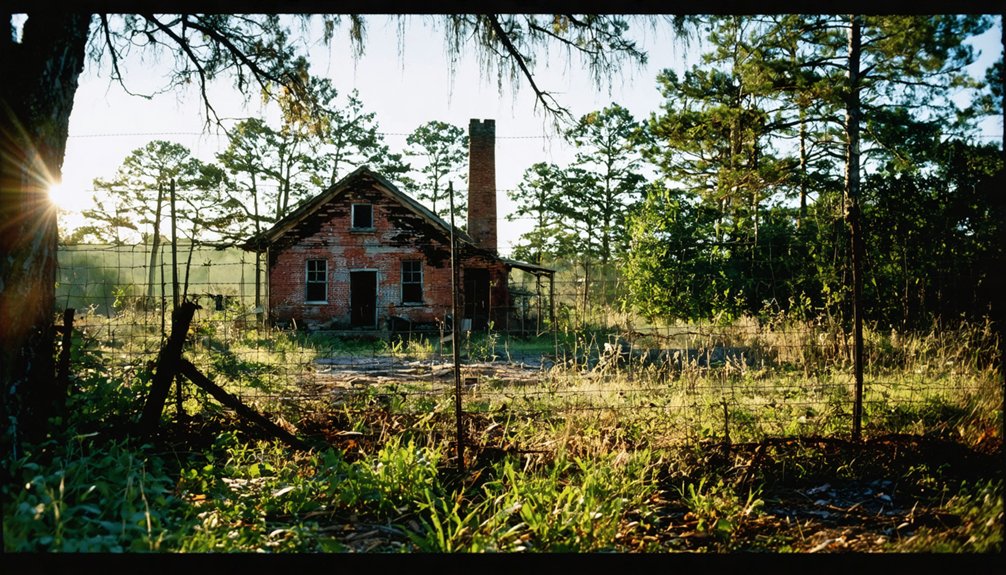
As time has erased the physical presence of Cedric, you’ll find no remaining structures or public landmarks at this former settlement. The site conditions reveal only natural landscape, situated about 3-4 miles southeast of present-day Roanoke and roughly a mile southwest of Bacon Level Church.
Access challenges are significant since the entire ghost town site remains in private hands. You can’t freely explore the area without the landowner’s explicit permission, and there aren’t any public facilities, historical markers, or designated viewing areas.
While you might glimpse the general vicinity from nearby vantage points around Roanoke or Bacon Level Church, these locations aren’t part of Cedric itself. The site’s current state, whether agricultural or forested, stays largely undocumented due to its private status.
Historical Preservation Status
You’ll find no official historic site protections in place for Cedric, as the ghost town sits entirely on private land without any preservation oversight.
The site hasn’t received designation on state or national historic registers, leaving it vulnerable to potential development or decay without formal documentation requirements.
Local preservation efforts remain limited by restricted access and the absence of public-private partnerships that could facilitate archaeological surveys or structural documentation.
No Protected Site Status
Despite its rich pottery-making heritage and pioneer settlement history, Cedric, Alabama lacks any official historical preservation status at federal, state, or local levels.
This absence of protected status creates significant preservation challenges for this historically significant ghost town, leaving its remaining structures and artifacts vulnerable to loss or alteration.
Without formal recognition, you’ll find:
- No mandatory review process for construction or demolition on the site
- No eligibility for preservation grants or funding that could help maintain historic structures
- No legal framework to protect archaeological findings or prevent development
As a privately owned property without historic designation, landowners maintain complete control over Cedric’s remnants, meaning they’re free to develop or modify the site without oversight from preservation authorities.
Private Land Access Restrictions
When exploring Cedric’s historical sites today, you’ll find that private land ownership severely restricts public access to this ghost town’s remaining structures and artifacts.
Since the entire town sits on private property, you can’t legally visit without first obtaining explicit permission from the landowners, who often deny access to protect their privacy and property rights.
These access challenges create significant hurdles for historians and preservationists trying to document and study Cedric’s past.
Without formal preservation agreements or public easements in place, the Alabama Historical Commission’s ability to protect and monitor historic resources remains limited.
While some landowners may voluntarily participate in preservation efforts, there’s no guarantee of sustained access or protection for Cedric’s remaining historical features.
Frequently Asked Questions
What Natural Disasters or Events Led to Cedric’s Abandonment?
You won’t find specific natural disasters causing Cedric’s abandonment, though potential flooding events could’ve played a minor role. Economic decline, rather than natural events, was more likely responsible.
Were There Any Native American Settlements in the Cedric Area Before?
Like footprints in time’s sand, Native tribes likely inhabited this region, though you’ll find limited conclusive evidence. Historical artifacts from Creek and Choctaw settlements have been discovered nearby.
How Did Residents Get Their Water Supply in Cedric?
You’d have gotten your water from local springs or hand-pumped wells, typical water sources for rural Alabama towns. Like nearby Battelle, you might’ve used wooden tanks and simple gravity-fed supply methods.
What Was the Average Property Size of Homesteads in Cedric?
You won’t find specific records of homestead sizes in Cedric – though agricultural practices and homestead structures likely followed regional patterns typical of northeastern Alabama’s small farming communities in that era.
Did Cedric Have a Post Office During Its Existence?
You won’t find evidence of a post office in Cedric’s history. Available records suggest nearby Roanoke likely handled mail services for this small settlement in northeastern Chambers County.
References
- https://en.wikipedia.org/wiki/Cedric
- https://inspiredsoutherner.com/haunted-history-tour-lets-you-hunt-for-ghosts-in-old-cahawba/
- https://digitalalabama.com/article/alabama-ghost-towns/page/3
- https://freepages.history.rootsweb.com/~gtusa/usa/al.htm
- https://digitalalabama.com/alabama-ghost-towns/cedric-alabama/2804
- https://en.wikipedia.org/wiki/List_of_ghost_towns_in_Alabama
- https://digitalalabama.com/alabama-ghost-towns/alabama-ghost-towns/9449
- https://en.wikipedia.org/wiki/Category:Ghost_towns_in_Alabama
- https://blog.batchgeo.com/ghost-towns/
- https://wikipedia.nucleos.com/viewer/wikipedia_en_all_maxi_2024-01/A/Standing_Rock
